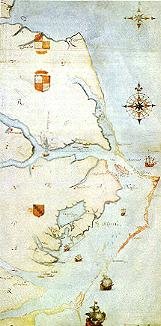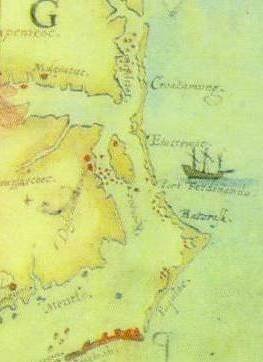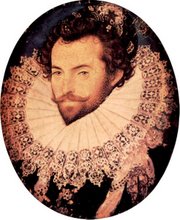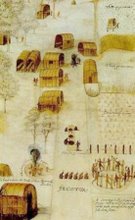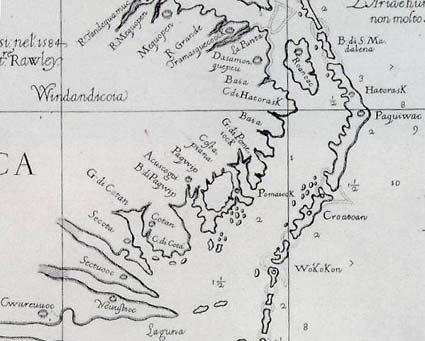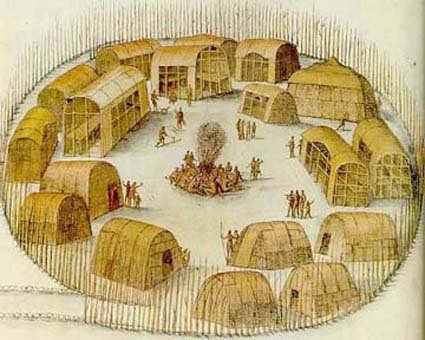Roberta Estes is a co-administrator of the Melungeon DNA Project and the Hatteras Island DNA Project and the Administrator of the Lost Colony DNA Project, among others. These are projects in which identification of Native American DNA is extremely important. This is a major break through! - History Chasers
Roberta Estes, robertajestes@att.net, http://www.dnaexplain.com
December 20, 2010
Sometimes scientific breakthroughs result from a combination of newly developed scientific techniques, synchronicity and opportunity. In other words, being at the right place at the right time, sprinkled with a little bit of luck.
For the tens of thousands of Americans today who seek their Native American ancestors via Y chromosomal DNA testing, that search just got a little bit easier, thanks to Leonard Trujillo, Thomas Krahn at Family Tree DNA and Rebekah Canada, the haplogroup Q project administrator.
For the past decade, since the advent of genetic genealogy, it has been accepted that subgroups of haplogroup C and Q were indicative of Native American ancestry. Specifically, subgroups C3b and Q1a3a, alone, are found among the Native peoples of North and South America. Other subgroups of haplogroup C and Q are found elsewhere in the world, not in North or South American, and conversely, C3b and Q1a3a are not found in other locations in the world. This makes it very easy to determine if your direct paternal ancestor was, or was not, Native American. Or so it seemed.
And then, of course, there were the baffling and tantalizing exceptions that caused me to suspect that there was yet at least one more Native American Y haplogroup. A few years ago, in the course of my business, I ran into a gentleman whose paternal line did not have an oral history of Native heritage, but his family was associated with a specific isolate group who did indeed have both a strong native oral heritage combined with documented (paper) Native ancestry. This grouping of individuals was found in colonial Virginia and may have been Saponi descendants. His haplogroup proved to be Q1. Q1 was not thought to be Native American at that time, but I was very suspicious, especially since his haplotype, meaning his actual marker values, matched no European people. Neither did he match any Native people. However, at that time, we had no further tools to address this mystery.
A few years later, another gentleman tested to be Q1a3, and his ancestor hailed from the PeeDee River region of South Carolina, an area known to be heavily populated with Native people historically, many of which became the Pee Dee and Lumbee today. However, haplogroup Q1a3 is also known to exist in people of European ancestry who have never lived stateside and who have absolutely no ancestry from the Americas. However, the haplotypes of these two Q1 and Q1a3 gentlemen were very different, suggesting no recent genealogical link, perhaps not within thousands of years.
I desperately wanted to know if perhaps the subgroup Q1a3 held different SNP markers for a European and a Native American subgroup within Q1a3, but again, the technology did not yet exist at that time to answer the question.
In 2009, 23andMe introduced wide spectrum testing, and both the Q1 and Q1a3 American gentlemen underwent testing at 23andMe with the hopes of isolating new SNPs that would shed light on their ancestry, but that was not to be. However, the SNPs we could confirm indeed did match each other, proving that both men were actually Q1a3. Their SNP values were P36.2+, MEH2+, M346+, L53+, L54+, L55+, L56+, L57+, L213+ and M3- which confirms haplogroup Q1a3 by virtue of M346+. The negative M3 indeed reaffirms that they are not Q1a3a. However, at that time, the SNPS designated by L were not yet available, and they turn out to be quite important in this story. All SNPs designated by L were discovered or confirmed by Thomas Krahn at Family Tree DNA and have been discovered in the past two years since the advent of the Walk Through the Y project.
In early 2009, two things happened at Family Tree DNA that would ultimately provide the building blocks to solve this mystery. Thomas Krahn began to offer the "Walk Through the Y" specialized test designed to be taken by only select individuals within haplogroups in order to discover additional SNP markers that will further define the haplogroup subgroups. To date, over 400 markers have been found in various haplogroups using this methodology. These new markers provide tools to further understand both recent and ancient genealogy and the movement and settlement of the Earth's peoples.
The second thing that happened in early 2009 is that Family Tree DNA began offering the Personalized DNA Reports for Y-line (and mitochondrial DNA) results through their website for clients who have tested at 37 markers or more.
Recently, Leonard Trujillo purchased the Y-line Personalized DNA Report. Leonard had tested at 67 markers and had also purchased the Deep Clade test, which reported his haplogroup results as Q1a3, but not Q1a3a (M3-). Leonard's question to me that he wanted to be answered in the Personalized DNA Report was whether or not his paternal line was indeed genetically Native. Unfortunately, I could not, at that time, give him a definitive answer. However, that was all about to change.
Leonard's situation is a little different from the earlier two. Leonard has a compelling family history that includes not just an oral history of Native ancestry on his paternal side, but the actual marriage record of his ancestor, Juan Estevan Trujillo (1739-1816) found in the Mission books of the Church of Santo Thomas de Abuquiu, NM (Marriages 1756-1826), that states: "Juan Estevan Trujillo, Indian of this pueblo, marriage to Juliana Martin, coyota and resident". The term coyota (the feminine form) is a term specific to New Mexico and indicated a person of mixed ancestry. The term is no longer in use. Juan Trujillo was called an Indian, not coyote (the masculine form), so he was not admixed.
Further investigation shows that Juan Estevan Trujillo was probably a Genizaros, a detribalized Plains Indian who was likely captured as a child by the Pueblo tribes and sold into slavery to either the Spanish or at the Pueblos. These Indian children were given Spanish names, taught to speak Spanish and were raised as Catholics. They often thought of themselves as Spanish, but they were indeed Indians, but without a tribe which equates in Native society to a cultureless soul. Many of these displaced individuals joined together and formed the Pueblo de Abiquiu in the 1750s, which is indeed where Juan Estevan Trujillo was married.
Leonard Trujillo's story was indeed compelling. Of the three individuals who were not Q1a3a (M3-), but looked to potentially be Native American, his genealogical history clearly stated that his ancestor was Native. But how do we scientifically prove this?
Leonard agreed to order the Walk Through the Y test with the hopes of discovering new SNPs that would identify him as an individual of Native ancestry within haplogroup Q1a3. At about the same time, and unbeknownst to us, a French haplogroup Q1a3 gentleman from Rebekah Canada's haplogroup Q project also ordered the Walk Through the Y test.
Testing only Leonard wasn't enough. His results, if any new SNPs were found, would need to be compared to a Q1a3 individual from Europe. Our firm hope was that there would be at least one differentiating SNP between the European sample and Leonard's sample which could then be used to separate European Q1a3 from Native Q1a3, assuming they were indeed separate haplogroup subgroups.
Indeed, Leonard's investment in science paid off, and he is the first person in the world to be proven as a member of the new haplogroup Q1a3a4 with two new SNPs discovered, L400 and L401. Furthermore, the European gentleman hit the bonanza as well, with 6 new SNPs discovered, L329-L334. Only one of these was also carried by Leonard, L331, meaning that between them, there are now 7 SNPs that differentiate European from Native Q1a3. Their common SNP lowest on the tree is L213, which both of them carry and is now a designator of the new subgroup Q1a3a.
If you're following closely at this point, you'll be wondering how Leonard and the French gentleman suddenly came to be included in haplogroup Q1a3a, when it was previously a Native American ONLY subgroup.
Well, our haplotree sprouted a new branch and the existing haplogroup branches are in the process of being shifted on the tree and renamed. So the branch previously known as Q1a3 is now Q1a3a. Confusing, yes, but also very necessary as science pushes forward with new discoveries.
Below is a chart with the new SNP discoveries and how those discoveries have shifted the haplotree relative to Native American ancestry. You can see that an entirely new group of SNPs has been discovered, and they now indicate haplogroup Q1a3a. This group includes the SNP, L213, common to both European and Native American groups. However, the next group, which includes M3 and three new "pages" SNPs now is the designation for subgroup Q1a3a1 which used to be Q1a3a. Q1a3a1 is now a Native American only haplogroup and Q1a3a now includes both Native and European members. The newly discovered haplogroup, Q1a3a4, designated by L400 and L401 is shown last on the list and is the new Native American haplogroup discovered thanks to Leonard Trujillo.
Table omitted here due to limitations of blog software. To view the article in its entirety click here:
http://www.genpage.com/NAHaplogroup.PDF
Testing of the old SNPs above was accomplished at various times and utilizing differing tests including the Backbone test, Deep Clade, individual SNPs, 23andMe and the Walk Through the Y. The new SNPs have been recently discovered and not everyone has been tested for these SNPS. Many are not yet commercially available and are used only in a research setting.
Below is a chart with the known haplogroups, individuals involved in this testing, their old and their new haplogroup designations.
Table omitted here due to limitations of blog software. To view the article in its entirety click here:
http://www.genpage.com/NAHaplogroup.PDF
Of course, this begs the question of whether Gentlemen 1 and 2 also carry SNPs L400 and L401. Yes, we are in the process of testing them as well as others who fall in the Traditional Native American haplogroup, formerly Q1a3a, now Q1a3a1.
The story is not yet over for haplogroup Q. Additional branches may be found on the Q haplotree, both for Native Americans and Europeans. This means that the haplogroups listed today may indeed change in the future as a result of new discoveries.
The current draft tree for haplogroup Q, compliments of Thomas Krahn and Rebekah Canada, is shown below, with the two Native American haplogroups, Q1a3a1 and Q1a3a4 and their associated SNPs underscored and shown in red. Reordering of the haplogroup Q tree also provides us with 3 additional Native subgroups, Q1a3a1a, Q1a3a1b and Q1a3a1c, shown in their new location on the haplogroup Q tree. Q1a3a2 is red, but not underscored as it is suspected but not yet confirmed as Native.
Table omitted here due to limitations of blog software. To view the article in its entirety click here:
http://www.genpage.com/NAHaplogroup.PDF
These discoveries to date, especially the discovery of the new Native American haplogroup, long suspected but never before proven, are thanks to pioneers Leonard Trujillo and Thomas Krahn, both of who were willing to tread ground previously unbroken. Without the unfailing support of Bennett Greenspan at Family Tree DNA, none of these discoveries would have been made. Family Tree DNA has subsidized the Walk Through the Y Project heavily by supporting this non-profit-making testing in the name of research. Funding for various tests has come from the various participants, but also from Rebekah Canada, myself and other donors.
To keep up with this project, watch Rebekah Canada's haplogroup Q project, Dr. Ana Oquendo Pabon's Q-AmerIndian project, Randy Garcia's Southwest US and Mexico Native project, the draft Y tree at Family Tree DNA and the Y haplotree at ISOGG. Links for references are provided below.
http://www.familytreedna.com/public/yDNA_Q/default.aspx
http://www.familytreedna.com/public/MexicoAmerindian/default.aspx
http://www.familytreedna.com/public/Amerind%20Y/default.aspx
http://ytree.ftdna.com/index.php?name=Draft&parent=31182976
http://www.isogg.org/tree/ISOGG_HapgrpQ.html
http://en.wikipedia.org/wiki/Haplogroup_Q_(Y-DNA)
http://www.dnaexplain.com/Publications/Publications.asp
This blog is © History Chasers
Click here to view all recent Lost Colony Research Group Blog posts 



















